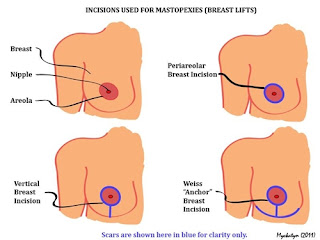One biggest problem every
woman has is about her breasts. Of course, whether there’s actually
nothing need to be worried about their breasts or not, women are
always curious about the way their breasts look. One of the problems
about breasts is sagging breasts. Sagging breasts is undoubtedly a
natural problem; sooner or later, as a woman ages, she will have her
breasts sagged. But, there are tips to avoid having sagging breasts
for young women by only using a supportive and right bra size for
your breasts.
Choose A Supportive Bra
Beyond any kinds of
plastic surgery or natural technique to fix your breasts appearance,
always consider choosing a supportive bra. Go to local bra store in
department store, specialty shop, or anything else. You can try to
ask the employer staff about which bras are fit your breasts because
these staffs are experienced and knowledgeable about both good
fashion and a wide selection of brands. Or you can also contact a
professional bra fitter in a beauty shop. There, you can have your
body measured. Some lingerie stores make this service available at
their shops for free. At last, if you shy asking about bras and
breasts to unknown people, you can always ask your female friends,
relatives, or even your mother. Have a company to the lingerie stores
so you can have advices about choosing a supportive bra for your
perfect breasts.
Know Many Size of Bras
Bras with wide back strap
are preferrable, because it supports more space for your breasts.
These bras include those with 3 until 6 hooks. Don’t opt for a
one-hook bra because it doesn’t support large breasts. If you want
to pick some lacy bras, you can choose those lacy and colorful bras
with larger sizes. Today, many bra and lingerie companies produce bra
with larger size. If you notice that you have larger breasts, always
choose larger sized bras. These bras won’t make your breasts
sagged. Or, if you are a sporty woman and you also want to avoid
having sagging breasts because of your activity, you can choose
sporty bras. Choosing supportive sporty bras, especially for women
with large breasts, is sometimes a little bit tricky. You can go
online or look at the catalogs to find the one that suits your
breasts.
Wear Your Bra Correctly
Now that you have found
the supportive and correct-sized bras for your perfect breasts, you
have to wear them correctly so that you can avoid sagging breasts.
First, you need to make sure that the back straps are hooked
correctly. Avoid having it twisted or moved, because sometimes after
washing and ironing, bras are curled up. Oh, yes, laundering bras is
another important thing. Always have them air-dried instead of drying
them dried using a dryer. It will make them last longer.
Back to how to wear bra
correctly. After hooking the straps, lean forward to make sure that
your breasts are perfectly located at the center. One tips: always
make sure your nipple line is on the same level with the middle part
of your arm. If it is not, check again.
Health is Number One
Okay, this is maybe not
related to bra sizes. Health is always the number one thing to
consider about every part of your body, including your breasts.
Sagging breasts, for example, can be avoided (or even reduced) by
giving massage to your breasts at least three until five times in a
week. Why? Because massaging your breasts will let free any stuck
fluid and blood flow within your breasts tissue. You can also use
some natural massage oil (or massage oil that is made specially for
breasts-massage) to make your breasts relax during massaging.
Consulting to doctor and
physician is also recommended. Mostly, doctor will suggest you to do
a weight loss plan, because larger-breasts women often accumulate fat
within their breasts tissue (although some other women may store
their fat in the hips, abdomen, or any other parts of their bodies).
Once you are in a diet plan, always keep in plan. Avoid inconsistent
diet plan because it is way more damaging than consistent weight gain
or loss program.
Always Use Bra
I mean, don’t use
cloths without using bra. Avoid being braless. Sagging breasts are
mostly and naturally caused by gravity, and going out braless will
loose your breasts without any hanger. Finally, gravity will
“stretch” your breasts tissue. But, in the other hand, using bra
more than 12 hours in a day is medically risky. Research reports that
using bra for more than half of a day may increase the risk of having
breast cancer. It is because bras make your breasts tight, and
finally prevent the blood within the breast tissue to flow regularly.



























